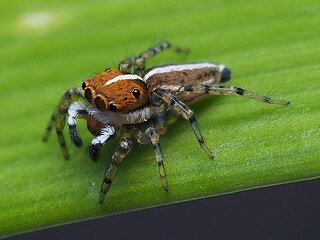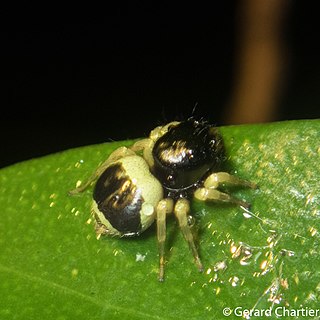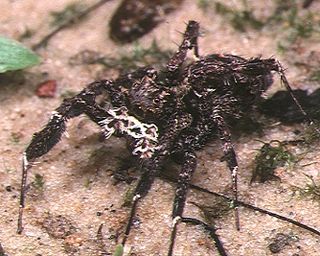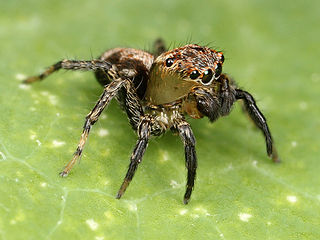Charippus is a genus of spiders in the jumping spider family, Salticidae.
Eupoa is a genus of spiders in the family Salticidae. Originally known only from one species from Vietnam, several other species have been described since 1997, all from Asia.

Ilargus is a genus of the spider family Salticidae.
Laufeia is a spider genus of the jumping spider family, Salticidae, with a mainly Asian distribution, where they are found on tree trunks and branches or among leaf litter.

Maeota is a spider genus of the jumping spider family, Salticidae.

Pystira is a genus of spiders in the jumping spider family Salticidae.
Thianitara is a genus of Southeast Asian jumping spiders that was first described by Eugène Louis Simon in 1903. As of August 2019 it contains only two species, found in Thailand, Indonesia, and Malaysia: T. spectrum and T. thailandica. It was briefly considered a junior synonym of Thiania until 2017, when it was revived by Jerzy Prószyński.
Wallaba is a monotypic genus of Guyanese jumping spiders containing the single species, Wallaba metallica. It was first described by Cândido Firmino de Mello-Leitão in 1940, and is found in Guyana. It was synonymized with Sidusa in 2015, but was revalidated by Jerzy Prószyński in 2017.
Xenocytaea is a genus of spiders in the family Salticidae (jumping spiders).

Zenodorus is a genus of the jumping spiders distributed from the Moluccas to Australia, including several islands of the Pacific. It was once considered a junior synonym of Omoedus, but this was later rejected by Jerzy Prószyński in 2017. At least one species, Z. orbiculatus, specializes on hunting ants.

The Spartaeinae are a subfamily of the spider family Salticidae. The subfamily was established by Fred R. Wanless in 1984 to include the groups Boetheae, Cocaleae, Lineae, Codeteae and Cyrbeae, which in turn were defined by Eugène Simon.

Salticinae is a subfamily of jumping spiders. It includes over 90% of the known species of jumping spiders. The subfamily is divided into two unranked clades: Amycoida and Salticoida.

Euophryini is a tribe of jumping spiders. It has also been treated as the subfamily Euophryinae.
Ajaraneola is a genus of African jumping spiders that contains two species, Ajaraneola mastigophora and Ajaraneola pajakwandy. The name of the genus derives from the name of forest goddess, Aja, in one of the languages of Nigeria, Yoruba. The genus was first described in 2011 from specimens of Ajaraneola mastigophora found in Nigeria. The second species was first described in 2021 from examples found in Uganda. The spiders are medium-sized and have a characteristic whip-like embolus.
Rumburak is a genus of spiders in the family Salticidae. It was first described in 2014 by Wesołowska, Azarkina & Russell-Smith. As of 2017, it contains 7 species, all from South Africa.
Junxattus is a monotypic genus of southeast Asian jumping spiders native to Sumatra. It contains the single species, Junxattus daiqini, first described by Jerzy Prószyński and Christa Deeleman-Reinhold in 2012. The genus was placed in the subfamily Euophryinae, the equivalent of the tribe Euophryini.
Yimbulunga foordi is the type species of the genus Yimbulunga. It is a species of jumping spider species that lives in South Africa. The male was described in 2014 by Wanda Wesołowska, Galina Azarkina and Anthony Russell-Smith. The female has not been identified. The spider is very small, with a carapace that is 1.8 mm (0.071 in) long and an abdomen 1.4 mm (0.055 in) long. Both the carapace and abdomen are rounded, which is reflected in the genus name, the Zulu word for spherical. The species is named for the arachnologist Stefan Foord. The pedipalps are brown with a small lobe on the palpal bulb and a thin embolus that coils all the way round. The shape of the embolus and the overall stout shape of the spider differentiate the species.
Padillothorax is a genus of southeastern Asian jumping spiders first described by Eugène Simon in 1901. As of April 2019 it contains only two species.
Tisanibainepta is a genus of southeast Asian jumping spiders first described by Dmitri V. Logunov in 2020. It includes three newly described species and three split from Tisaniba with several distinctions, including the embolus shape and the median septum present on the epigynum.







